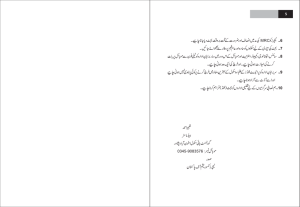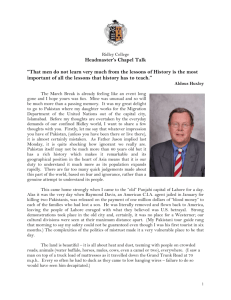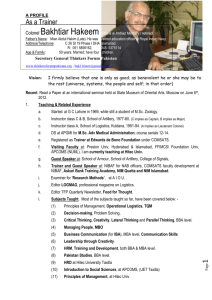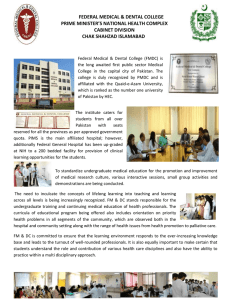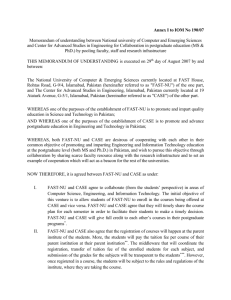Document 13329173
advertisement
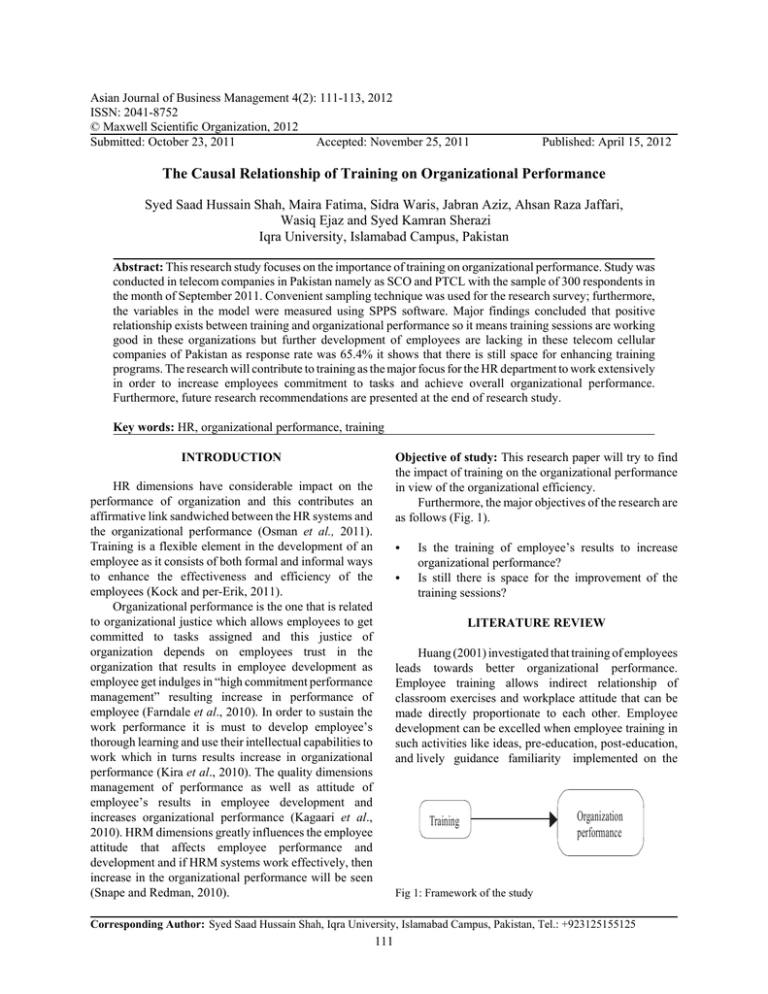
Asian Journal of Business Management 4(2): 111-113, 2012 ISSN: 2041-8752 © Maxwell Scientific Organization, 2012 Submitted: October 23, 2011 Accepted: November 25, 2011 Published: April 15, 2012 The Causal Relationship of Training on Organizational Performance Syed Saad Hussain Shah, Maira Fatima, Sidra Waris, Jabran Aziz, Ahsan Raza Jaffari, Wasiq Ejaz and Syed Kamran Sherazi Iqra University, Islamabad Campus, Pakistan Abstract: This research study focuses on the importance of training on organizational performance. Study was conducted in telecom companies in Pakistan namely as SCO and PTCL with the sample of 300 respondents in the month of September 2011. Convenient sampling technique was used for the research survey; furthermore, the variables in the model were measured using SPPS software. Major findings concluded that positive relationship exists between training and organizational performance so it means training sessions are working good in these organizations but further development of employees are lacking in these telecom cellular companies of Pakistan as response rate was 65.4% it shows that there is still space for enhancing training programs. The research will contribute to training as the major focus for the HR department to work extensively in order to increase employees commitment to tasks and achieve overall organizational performance. Furthermore, future research recommendations are presented at the end of research study. Key words: HR, organizational performance, training Objective of study: This research paper will try to find the impact of training on the organizational performance in view of the organizational efficiency. Furthermore, the major objectives of the research are as follows (Fig. 1). INTRODUCTION HR dimensions have considerable impact on the performance of organization and this contributes an affirmative link sandwiched between the HR systems and the organizational performance (Osman et al., 2011). Training is a flexible element in the development of an employee as it consists of both formal and informal ways to enhance the effectiveness and efficiency of the employees (Kock and per-Erik, 2011). Organizational performance is the one that is related to organizational justice which allows employees to get committed to tasks assigned and this justice of organization depends on employees trust in the organization that results in employee development as employee get indulges in “high commitment performance management” resulting increase in performance of employee (Farndale et al., 2010). In order to sustain the work performance it is must to develop employee’s thorough learning and use their intellectual capabilities to work which in turns results increase in organizational performance (Kira et al., 2010). The quality dimensions management of performance as well as attitude of employee’s results in employee development and increases organizational performance (Kagaari et al., 2010). HRM dimensions greatly influences the employee attitude that affects employee performance and development and if HRM systems work effectively, then increase in the organizational performance will be seen (Snape and Redman, 2010). C C Is the training of employee’s results to increase organizational performance? Is still there is space for the improvement of the training sessions? LITERATURE REVIEW Huang (2001) investigated that training of employees leads towards better organizational performance. Employee training allows indirect relationship of classroom exercises and workplace attitude that can be made directly proportionate to each other. Employee development can be excelled when employee training in such activities like ideas, pre-education, post-education, and lively guidance familiarity implemented on the Training Organization performance Fig 1: Framework of the study Corresponding Author: Syed Saad Hussain Shah, Iqra University, Islamabad Campus, Pakistan, Tel.: +923125155125 111 Asian J. Bus. Manage., 4(2): 111-113, 2012 Table 1: Co- Efficient; 2: Stand error in parenthesis; 3: t-value in Brackets; 4: Significance vale; P: in italics Constant Training(IV1) R square F -0.175 1.013 0.654 279.318 (0.154) (0.061) [-1.138] [16.713] 0.257 0.000 0.000 agreement. The statistical package for Social Sciences Program (SPSS) was used for analysis. RESULTS & DISCUSSION Table 1 shows that a significant and positive relation lies between the independent variable training and dependent variable organizational performance that is significant with the past researches of (Delaney and Mark, 1996; Koch and McGrath, 1996; Huang, 2001; Mitki and Ram, 2007; Jackson, 2008; Noonan, 2008; Ford, 2009; Kira et al., 2010). Furthermore, R Square 0.654 shows that the model is a fit one and 65.4 (%) percent deviation is observed caused by the independent variable in the model. Whole analysis shows that the variable training, which is the independent variables, regresses the dependent variable and provides considerable outcome where significance value (P) is less than 0.050, F value is equal to 279.318 and the value of R square is greater than 0.60 while less than 1 value is observed for the standard error. performance of an organization (Ford, 2009). Employee training and development can be successful through different training schemes and productive to the efficiency of industrial performance if employee’s professional interests are related to employee training and development (Jackson, 2008). Employees who possesses Intensive training approach attitude enables the company to speedily adjust the new distinctive organizational performance (Mitki and Ram, 2007). Chat and feedback mechanism allows great development in the training process such as surveys that aid to encourage many employees used as a training tool that is easy to use and will work for employee development and organizational efficiency (Noonan, 2008). In order to sustain the work performance it is must to develop employee’s thorough learning and use their intellectual capabilities to work which in turns results as increase in organizational performance (Kira et al., 2010). For employee development, training has been considered as one of the part of HR policy and marked as superior performance HR systems (Delaney and Mark, 1996). Moreover, a significant relation is observed between the training of employee and organizational superior performance (Koch and McGrath, 1996), as training allows employees to have multidimensional skills. RECOMMENDATIONS C C C Framework of study: Hypothesis: There is a significant effect of training on employee commitment. C METHODOLOGY In this study non-probability, random sampling was used. Two companies relating to telecom sector of Pakistan were the population of this study. The companies were the only telecom landline service providers companies namely as PTCL and SCO. The potential respondent of this study are employees of the companies. A total of 362 questionnaires were distributed to these companies and out of these questionnaires 300 questionnaires were retrieved back and were processed in this study. Thus, a response rate of 82.87% was achieved in this study. This survey was conducted in the vicinity of Rawalpindi and Islamabad in the month of august. The scale to measure organizational performance and training was Likert scale ranking (5- Point) where 1 is highest degree of disagreement and 5 is the least degree of The sample size of study is low, so it cannot be generalized therefore study could be generalized by increasing the sample size to have a wider focus. The results can be tested by adding new variables to the model e.g. feedback, mentoring, on the job training etc. This study has been conducted purely with the employees of PTCL and SCO, Islamabad and Rawalpindi; however, it can be extended to the other organizations as well e.g., banking sector, insurance companies, and construction companies etc. More training sessions may be considered in order to increase the development of employees that is directly related to organizational performance. CONCLUSION Based on the above research the study investigated that training of employees significantly enhances employee development, therefore training has valuable effects on the organizational performance. REFRENCES Delaney, J.T. and A.H. Mark, 1996. The impact of human resource management of perceptions of organizational performance. Acad. Mgt. J., 39: 949-969. 112 Asian J. Bus. Manage., 4(2): 111-113, 2012 Kock, H. and E. Per-Erik, 2011. Formal and integrated strategies for competence development in SMES. J. Eur. Indus. Train., 35(1): 71-88. Mitki, Y. and H. Ram, 2007. Innovative training in designing corporate identity. Indus. Commer. Train., 39(3): 174-179. Noonan, J., 2008. Using collaboration tools to improve training. Indus. Commer. Train., 40(1): 51-53. Osman, I., C.F.H. Theresa and C.G. Maria, 2011. The relationship between human resource practices and firm performance: An empirical assessment of firms in Malaysia. Bus. Strat. Series, 12(1): 41-48. Snape, E. and T. Redman, 2010. HRM dimensions, organizational citizenship behaviour and performance: A multi-level analysis. J. Mgt. Stud., 47:1219-1247, Doi:10.1111/j.1467-6486. 2009. 00911.x. Farndale, E., H.H. Veronica and K. Clare, 2010. High commitment performance management: The roles of justice and trust. Pers. Rev., 40(1): 5-23. Ford, L., 2009. Improving training transfer. Indus. Commer. Train., 41(2): 92-96. Huang, T.C., 2001. The relation of training practices and organizational performance in small and medium size enterprises. Educ. Train., 43(8-9): 437-444. Jackson, S.W., 2008. Training in British industry. Educ. Train., 50(1): 10-13. Kagaari, J., C.M. John and M.N. Joseph, 2010. Performance management practices, employee attitudes and managed performance. Int. J. Educ. Manage., 24(6): 507-530. Kira, M., F.M. Van Eijnatten and B.B. David, 2010. Crafting sustainable work: Development of personal resources. J. Organ. Change Manag., 23(5): 616-632. Koch, M.J. and R.G. McGrath, 1996. Improving labor productivity: Human resource management policies do matter. Strat. Mgt. J., 17: 335-354. 113

